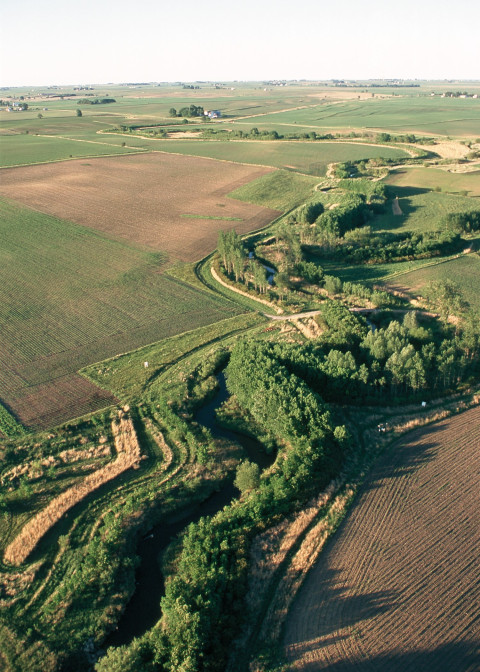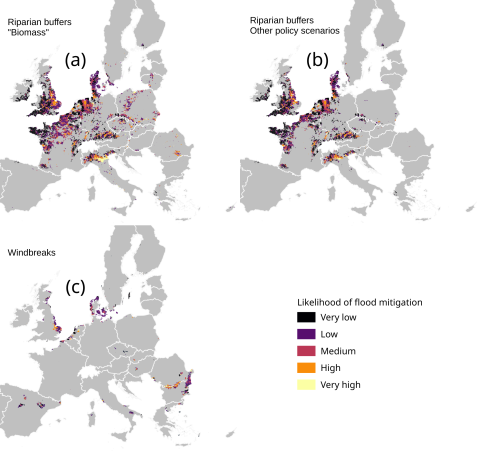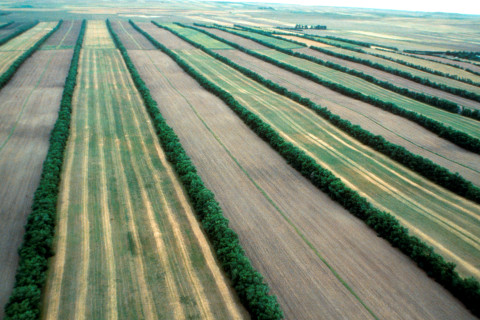A new spatial modelling study across over 81,000 landscapes in Europe shows that large-scale deployment of perennial biomass plantations can effectively reduce nitrogen emissions to water and soil loss by wind erosion.
The riparian buffers and windbreaks will also deliver biomass and additional environmental benefits, with limited negative effects on current agricultural production.
“We have previously shown that there is a substantial potential for using so called multifunctional biomass production systems in Europe. By implementing these on a large scale, we can mitigate many of the impacts we have caused by large-scale agriculture in EU and maintain or increase the overall biomass productivity at the landscape scale. What we have done this time, is to exemplify how this can be done and quantify the effects”, says Oskar Englund, Associate Professor in Environmental Engineering at the Mid Sweden University, and lead author of two recent studies on multifunctional biomass plantations. Associate Professor Blas Mola from the School of Forest Sciences at the University of Eastern Finland is among the co-authors of both these studies.
The increasing demand of biomass for energy and biomaterials, necessary for meeting our climate objectives, risks increasing the pressure on land and thus cause further environmental impacts. Humans already manage about half of the Earth’s land area productively, causing environmental impacts such as eutrophication, soil erosion, soil carbon losses, and impacts on biodiversity. But a recent article in Communications Earth & Environment shows that a strategic introduction of perennial crops, such as grasses and fast-growing trees in the form of riparian buffers and windbreaks, can co-deliver biomass and environmental benefits.
“According to our model, riparian buffers are primarily relevant in northwestern and central Europe, while windbreaks are generally relevant in coastal areas and other areas subject to recurring strong winds. Denmark is one example of where the potential for this kind of ‘strategic perennialization’ is massive. Implementing riparian buffers on a large scale in Europe can result in that up to a third of all nitrogen emissions to water is avoided, while 33 million tonnes of carbon is stored in soils, and 3 million tonnes of agricultural soil, that would otherwise be eroded, is preserved. It is also interesting that both riparian buffers and windbreaks can be effective for flood mitigation, which is currently high on the political agenda in Europe (Fig. 3)“
The new study is based on a new spatial model that utilizes existing spatial data from multiple international research projects, to indicate where riparian buffers could be effective in mitigating nitrogen emissions to water, and where windbreaks could be effective in mitigating soil erosion by wind.
The model then quantifies how large areas within 81,000 individual landscapes need to be covered by the respective production systems to result in desired impact mitigation, under different scenarios with different incentives for implementation. Finally, the model estimates the resulting biomass production and quantifies environmental co-benefits, that is, mitigation of other impacts than the intended: increased soil carbon, reduced soil erosion, and avoided flooding events.
“What is especially interesting about these options is that we can harvest both buffers and windbreaks for biomass instead of setting aside land for the purpose of impact mitigation. This means a higher land use efficiency, which is necessary to uphold or increase biomass production to supply the emerging bioeconomy. This clearly shows that we can resolve many of our self-inflicted environmental problems without necessarily sacrificing agricultural productivity – if we are just a bit clever."
The study is conducted by researchers at the Mid Sweden University, Chalmers University, Lund University, the Swedish University of Agricultural Sciences, the University of Eastern Finland and the Joint Research Centre of the European Commission.
“While our modelling framework, that identifies where these production systems could be established and quantifies all the effects, is rather complicated, the logic and theory isn’t. This is old knowledge, only adapted to modern agriculture. In case society is serious about meeting environmental objectives, including climate targets, multifunctional production systems is an obvious way to go”, Dr. Englund continues.
Multifunctional biomass production systems could contribute to the objectives of multiple EU policies and also be eligible for compensation within the EU Eco-scheme framework.
“This is important because these systems will not be established unless farmers receive proper compensation for the societal benefits they provide. It is also important that local conditions are taken into account, as the design and effects of these systems will differ from location to location. It is therefore necessary to raise the knowledge of opportunities with multifunctional biomass production systems among all EU member states, before country specific Eco-scheme options are designed and introduced in the new CAP.”
Dr. Englund stresses that there is a lot of work ahead. There are many other possible systems to model and several impacts that deserve special attention.
“Biodiversity is one - it has been heavily discussed the past years, both in relation to agriculture and forestry. How can biomass plantations contribute to enhancing conditions for biodiversity? That is a highly interesting question that we are currently working on. We are also close to finishing a study on how grass can be introduced into annual crop production with the primary objective to enhance soil carbon.”
Read more:
Englund, O., Börjesson, P., Mola-Yudego, B., Berndes, G., Dimitriou, I., Cederberg, C., Scarlat, N., (2021). Strategic deployment of riparian buffers and windbreaks in Europe can co-deliver biomass and environmental benefits. Communications Earth & Environment, 2:176, https://doi.org/10.1038/s43247-021-00247-y
Englund, O., Börjesson, P., Berndes, G., Scarlat, N., Dallemand, J-F., Grizzetti, B., Dimitriou, I., Mola-Yudego, B., Fahl, F., (2019). Beneficial land use change: strategic expansion of new biomass plantations can reduce environmental impacts from EU agriculture. Global Environmental Change, 60, 101990. https://doi.org/10.1016/j.gloenvcha.2019.101990
Englund, O., Dale, V.H., Kline, K.L., Dimitriou, I., Mola-Yudego, B., Murphy, F., English, B., McGrath, J., Busch, G., Negri, M.C., Brown, M., Goss, K., Jackson, S., Parish, E.S., Cacho, J., Zumpf, C., Quinn, J., Mishra, S.K., (2020). Multifunctional perennial production systems for bioenergy: performance and progress. WIREs Energy & Environment, 9(5), e375. https://doi.org/10.1002/wene.375






